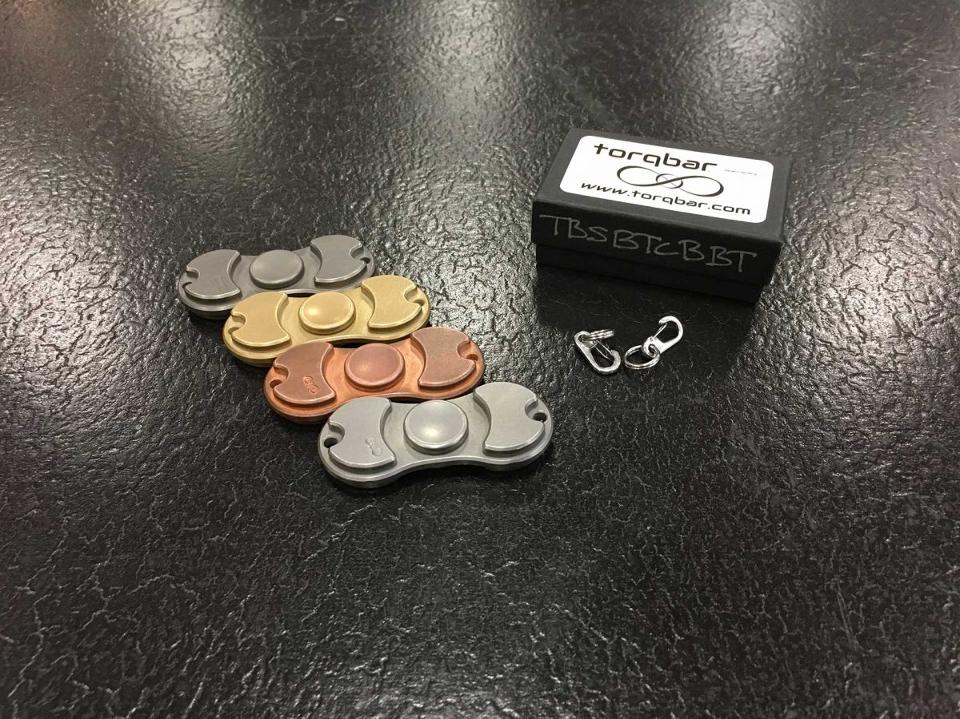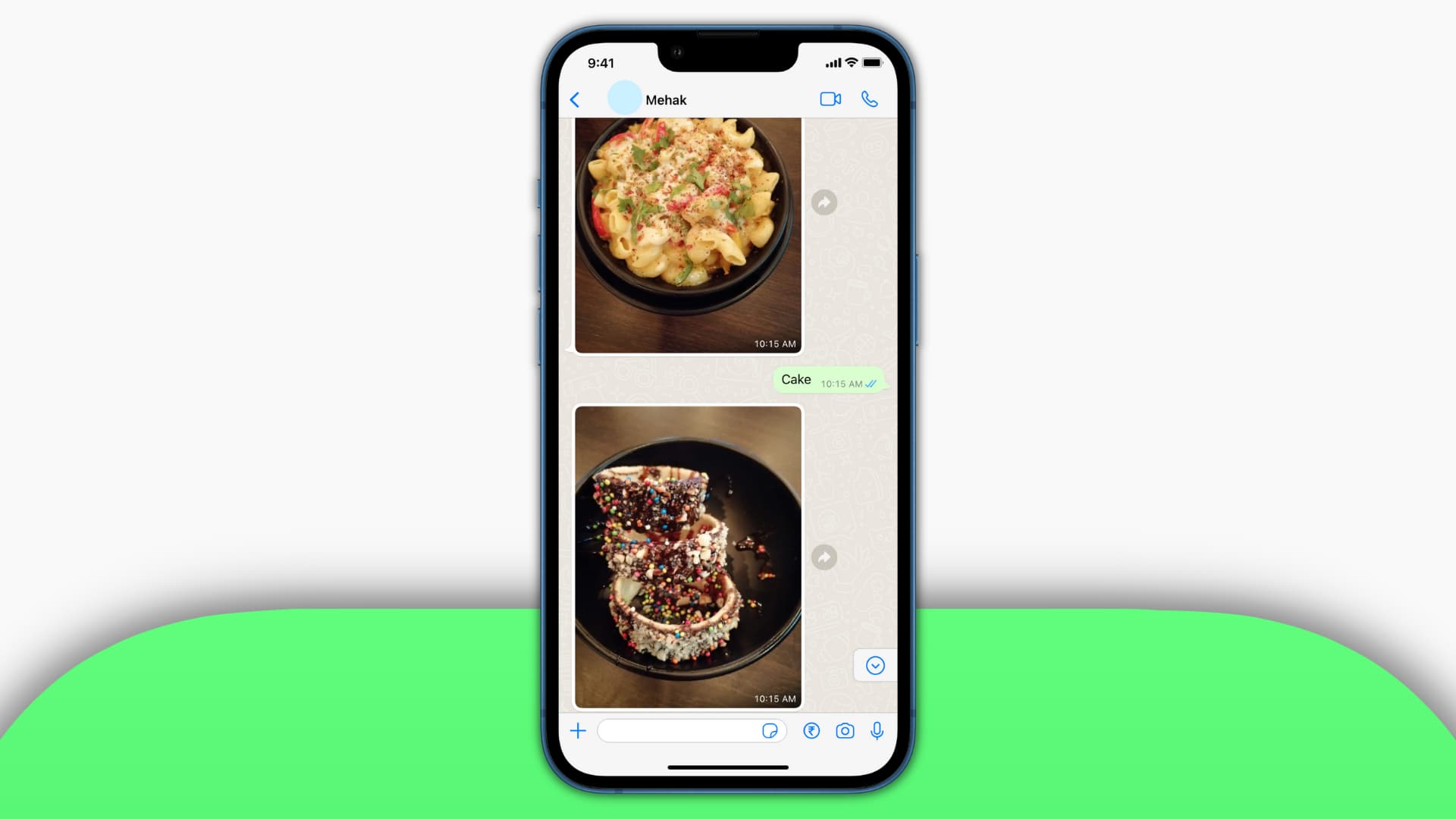If you’re in the market for something to curb your nail-biting or need an innocuous outlet for your nervous or bored energy, fidget spinners might just be the answer. After extensive testing — and despite a couple flaws — we all, at the very least, really like them and take them with us wherever we go, but which fidget spinner is for you?

The titanium, brass, copper, stainless steel Torqbar, two key chain attachments, and a single bar’s packaging. Image: James Plafke
Out of the handful of high-end spinners, MD Engineering’s Torqbar could be billed as the flagship fidget spinner much in the way Apple’s iPhone is often considered the premier smartphone. Like the iPhone, its superb build quality and “it just works” usability create a niche craze. Its currently limited availability only strengthens its Apple-cult-like following. The community around the Torqbar — from Facebook groups and YouTube reviews to forums about everyday carry items — is small, but extremely passionate. Due to its limited availability and passionate community, the Torqbar’s going price on eBay is kind of insane (we’ve seen numbers crest $400 for a single spinner, over twice their retail price), and is reminiscent of the niche, I-can’t-believe-someone-would-pay-so-much-for-that market for custom keyboards and keycaps. Regardless of the price, as our testing found, there’s a decent chance that once a Torqbar is placed in your hands, you’ll want one.
The current iteration of the Torqbar comes in four different materials: brass ($139), copper ($149), stainless steel ($179), and titanium ($199). As their “fidget spinner” moniker suggests, you hold the bar in between your thumb and a finger — placing your fingers on the smooth, concave, button-like finger pads — and just kind of idly flick and spin them. For a more in-depth explanation of why you’d want to do that and the benefits we found from doing so, check out our hands-on testing here, but in short: you’d want to spin them for the same reason you bite your nails or mindlessly click a pen over and over. You can flick the bar back and forth, or go for longer spins and zone out a little while you stare at the helicopter blade-like spinning.
The copper is the heaviest Torqbar, weighing in at around 60 grams, while the titanium Torqbar is by far the lightest, weighing in at around 31 grams. The brass and stainless steel spinners are only a few grams lighter than the copper, and the weight difference isn’t noticeable between the non-titanium spinners. The heavier the Torqbar, the longer the maximum spin time. We’ve managed to get the brass and copper to pass four minutes of smooth spinning, while the titanium one regularly nears three. Generally, though, most of us found ourselves just flicking it back and forth rather than going for long spins.Along with different spin times and different colors, each metal makes a different, subtle noise when spinning, and the noises — rather than weight or aesthetics — actually became the surprise metric that helped decide which Torqbar each tester preferred. It’s hard to describe and capture on camera, but the spin noises were all kind of soothing in their own way, like a soft chime mixed with a low whirring. You wouldn’t be able to hear it too well, for example, in an office filled with chatter, but you could easily hear it in a quieter office.
If you’re in the market for something to curb your nail-biting or need an innocuous outlet for your nervous or bored energy, fidget spinners might just be the answer. After extensive testing — and despite a couple flaws — we all, at the very least, really like them and take them with us wherever we go, but which fidget spinner is for you?

The titanium, brass, copper, stainless steel Torqbar, two key chain attachments, and a single bar’s packaging. Image: James Plafke
Out of the handful of high-end spinners, MD Engineering’s Torqbar could be billed as the flagship fidget spinner much in the way Apple’s iPhone is often considered the premier smartphone. Like the iPhone, its superb build quality and “it just works” usability create a niche craze. Its currently limited availability only strengthens its Apple-cult-like following. The community around the Torqbar — from Facebook groups and YouTube reviews to forums about everyday carry items — is small, but extremely passionate. Due to its limited availability and passionate community, the Torqbar’s going price on eBay is kind of insane (we’ve seen numbers crest $400 for a single spinner, over twice their retail price), and is reminiscent of the niche, I-can’t-believe-someone-would-pay-so-much-for-that market for custom keyboards and keycaps. Regardless of the price, as our testing found, there’s a decent chance that once a Torqbar is placed in your hands, you’ll want one.
The current iteration of the Torqbar comes in four different materials: brass ($139), copper ($149), stainless steel ($179), and titanium ($199). As their “fidget spinner” moniker suggests, you hold the bar in between your thumb and a finger — placing your fingers on the smooth, concave, button-like finger pads — and just kind of idly flick and spin them. For a more in-depth explanation of why you’d want to do that and the benefits we found from doing so, check out our hands-on testing here, but in short: you’d want to spin them for the same reason you bite your nails or mindlessly click a pen over and over. You can flick the bar back and forth, or go for longer spins and zone out a little while you stare at the helicopter blade-like spinning.
The copper is the heaviest Torqbar, weighing in at around 60 grams, while the titanium Torqbar is by far the lightest, weighing in at around 31 grams. The brass and stainless steel spinners are only a few grams lighter than the copper, and the weight difference isn’t noticeable between the non-titanium spinners. The heavier the Torqbar, the longer the maximum spin time. We’ve managed to get the brass and copper to pass four minutes of smooth spinning, while the titanium one regularly nears three. Generally, though, most of us found ourselves just flicking it back and forth rather than going for long spins.
Along with different spin times and different colors, each metal makes a different, subtle noise when spinning, and the noises — rather than weight or aesthetics — actually became the surprise metric that helped decide which Torqbar each tester preferred. It’s hard to describe and capture on camera, but the spin noises were all kind of soothing in their own way, like a soft chime mixed with a low whirring. You wouldn’t be able to hear it too well, for example, in an office filled with chatter, but you could easily hear it in a quieter office.
The Torqbar is packaged in a little box slightly bigger than the spinner itself, and comes with a small key chain attachment that easily clips onto one of the two docking points on the bar. Though the attachment is small and lightweight, you won’t want to spin the Torqbar with it still attached, as it throws the bar off-kilter. We found that attaching the Torqbar to your key chain comes down to personal preference, but if you’re the type to frequently misplace things, it’s probably a good idea to attach your spinner to something you don’t often lose.
Aside from the larger-than-you’d-expect price tag, we did run into one more potential drawback. Out of the handful of tester units we received, a small percentage of them felt gritty after a week or so of extended use. The spinning started making a grittier sound, spin times were cut almost in half, and you could feel a kind of grind in the finger pads as it spun. Due to the way the Torqbar is constructed — a solid metal body with a bearing enclosed by the two finger pads that screw on and off — particulate can find its way into the bearing, whether it be dirt, sand, grit, or lint. Your fingers will be all over the thing, and you’ll likely keep it in your pocket when not in use, so that makes sense. MD Engineering notes this in its FAQ and even provides proper cleaning instructions, but out of the two of our spinners that got gritty (one brass, one titanium), the titanium one only got somewhat better after cleaning (still a little gritty) whereas the brass returned to perfect condition. We received two identical titanium spinners, and one of the titanium spinners is still perfect and was used just as frequently and in the same manner as the gritty one, so we can’t attribute the potential to get gritty to the type of metal used to construct the bar. If you jump onto the spinner bandwagon, it’s absolutely worth nothing that you should probably clean these things once a week or so, and once a spinner gets gritty, it’s better to be safe than sorry and you shouldn’t spin it until you clean it. A cleaning only takes a few minutes, and while it’s a bit tedious, it’s no more tedious than cleaning out your coffee thermos every night after you get home from work. However, you will need a can of compressed air — a cleaning tool you might not have just lying around the house.
Ultimately, despite a high price tag and the grit issue we occasionally faced, we all really like the Torqbar. They look sophisticated, they feel great in your hand, and we all noticed varying beneficial effects of having it around for fidgeting — even if, at the very least, the effect was simply that it’s enjoyable.
[sOURCE:-Forbes]




